Tidbits From the ARRB Depositions
Recently the Assassination Records Review
Board released transcripts of depositions they took from personnel who
were involved in the autopsy of President Kennedy at Bethesda Naval Hospital.
After reading them for a few hours, I found some interesting information
in these depositions, some never revealed before. I will provide a brief
description of each topic and let you read the original pages of the deposition
for yourself.
Allow me to abuse an author's privilege for
a moment. There were a few things in the accompanying cover letter and
list of contents of the master set of exihibits which struck a nerve. And
you might find the information interesting and useful. In the cover letter
the ARRB said:

Yet, after reading all the material and the list of exhibits, I could
find no indication that they had located a couple of items which I suggested
that they track down. I had sent the ARRB an e-mail suggesting that a tape
recording of the autopsy was made. I can find no indication that the ARRB
actually looked for and tracked down any recording of the autopsy. We do
not yet know if Humes was pressed about this matter. Until I see that the
ARRB was able to resolve this matter, I believe that a recording was made
during or after the autopsy by Commander Humes and that he deliberately
destroyed the evidence after learning about the throat wound. Here is my
first letter and my follow-up letter, which mentions the recording:
Subject: June 4, 1998 meeting
Date: Wed, 03 Jun 1998 10:10:33 -0400
From: AnthonyMarsh <amarsh@quik.com>
To: Eileen Sullivan <Eileen_Sullivan@jfk-arrb.gov>
I just received a notice from the ARRB about the June 4, 1998 meeting.
I am worried that this meeting may be the last opportunity to raise issues
about citizen suggestions of which JFK assassination materials the ARRB
should locate and acquire. Several researchers were hoping to compile a
list of suggestions and present it as a united effort. But I fear that
events and time will delay that effort past an unknown cutoff date. So, I
am submitting my own list in hopes that these items may be considered at
the June 4, 1998 meeting.
1. The Dallas Police Department tape of the motorcade on channel 1 which
was recorded on November 22, 1963, especially that portion which covered
the time frame of the shooting in Dealey Plaza. I have filed many FOIA
requests for that tape and all of the agencies have refused to release the
tape. A couple of years ago, I visited the National Archives and searched
through the HSCA collection of tapes and found that the DPD tape was missing.
When I asked about it, I was told that it was locked up in a safe and would
not be released to me. Independent researchers deserve the chance to
analyze the tape for themselves, especially since the US Department of
Justice declined to do so when the HSCA suggested that further analysis be
made.
2. All research materials and work product from the acoustical firm of
Bolt, Beranek and Newman, and scientists Weiss and Aschkenasy from Queens
College, New York. The quality of the reproductions of these materials in the
HSCA volumes is so poor that serious research can not be accomplished using
them. And some exhibits could not be included in the volumes, such as the
strip charts of acoustical data and raw computer files. But now the
National Archives does have the ability to reproduce such materials.
Likewise, all research materials and work product from the National Academy of Sciences'
Committee on Ballistic Acoustics, including private studies done by its panel
members, such as raw computer files from Richard Garwin at the Tom Watson Research
Center at IBM. Although Garwin's paper had stated that he would make available
a copy of his raw computer files, he has refused to make them available to me
because I believe there was a conspiracy.
3. President Kennedy's brain. This is pure speculation on my part, but if
I don't tell you then you can claim that you had never considered the idea.
I do not believe that President Kennedy's brain was reburied with his body,
but there may be some non-invasive way to examine the grave site to determine
if it was at all possible, without the need to seek an exhumation order.
Several years ago, scientists were able to examine historic graves without
disturbing them at a historic church at St. Mary's City. The same technique
or a similar technique might be used to find out if there are any additional
objects in the grave. I would also suggest that a representative contact
the Boston Archdiocese and request that it search its holding. Living in the
Boston area for so many years, I have seen how closely affiliated the Kennedy
family was with the Catholic church. Now, I don't know enough about Catholic
doctrine to know if the Kennedy family would destroy the brain, but
perhaps they would have felt that destroying it would have been against their
religious beliefs and they would have sought the counsel of their friend
Cardinal Cushing. Most large Dioceses have very secure vaults where the most
Holy Relics are kept. Cardinal Cushing could have placed the container in one
of those vaults. And presumably placing it in such a vault would keep the
material safe from any government jurisdiction.
4. Do you want researchers and authors to submit copies of their books,
articles, and research materials for the benefit of future researchers?
Or would this be so unwieldy and open up such a can of worms that you
would rather not send out a request? Researchers already voluntarily
give materials and books to the Kennedy Library and the National Archives, but
should those be considered JFK records?
If there is a cutoff date for suggestions, please send out an advisory.
Anthony Marsh
10 Webster Ave. Apt. 1-2
Somerville, MA 02143
617-625-8554
Subject: Re: June 4, 1998 meeting
Date: Wed, 03 Jun 1998 17:19:05 -0400
From: AnthonyMarsh <amarsh@quik.com>
To: Eileen Sullivan <Eileen_Sullivan@jfk-arrb.gov>
Eileen Sullivan wrote:
>
> Dear Mr. Marsh:
>
> Thank you for your note and for your suggestions. I have forwarded it to
> the appropriate staff members.
>
> The meeting on June 4, 1998, is an open meeting. It is not a hearing, and
> there will be no testimony from witnesses. The Board will simply be
> conducting business in public, and the Board members will be discussing
> possible recommendations for the final report that have arisen out of the
> Review Board's experiences in releasing records.
>
> The Board is soliciting written comments and recommendations from the
> public about this issue, and all written submissions should be sent to the
> Review Board offices by July 1, 1998.
>
> With regard to suggestions from the public about specific materials that it
> believes the Board should locate and acquire, there is no cut-off date,
> however, keep in mind that the ARRB's mandate expires on September 30,
> 1998.
>
> I hope this clears up any misunderstandings about testimony from witnesses
> and deadlines.
>
> Sincerely,
>
> Eileen Sullivan
Thank you, Eileen, for the quick and helpful reply. I have thought of
one more thing
which the ARRB should at least consider looking for, but it is quite
speculative and
I am not even sure how they would look for it.
5. There may be a tape recording of the autopsy at Bethesda Hospital. In
most autopsies
the coroner or autopsy doctor makes a cassette tape recording of the
whole procedure.
If someone can prove that thousands of such tape recordings were made of
autopsy prior
November 22, 1963 at Bethesda, that makes it highly likely that such a
recording was
made of President Kennedy's autopsy. If so, it may still exist in the
records at
Bethesda or at a Naval facility, or possibly it is in Dr. Humes'
possession. Reportedly,
Dr. Humes was questioned by press and researchers after his HSCA
testimony and he
remarked that the HSCA had their chance and blew it. Perhaps he was
referring to the
fact that the HSCA had a chance to ask him on the record if he had made
a tape recording
of the autopsy and they simply overlooked that possibility. So, I do not
want the ARRB
to simply overlook that possibility.
Anthony Marsh
10 Webster Ave. Apt. 1-2
Somerville, MA 02143
617-625-8554
There are some interesting items in the list of
almost 300 exhibits. One which caught my eye was MD 74 (M), which is unavailable
for public release until September 30th. A few years ago I was attending
a COPA conference at which various authors were debating the interpretation
of the skull X-rays. I helped arrange a private meeting between Dr. David
Mantik and Dr. Randy Robertson. I suggested to both of them that one thing
which would help clarify their positions would be for them each to obtain
a life-sized plastic model of a human skull and mark on them (independently,
of course) what they think is the extent of the skull wound. Dr. Mantik
belittled my suggestion and stated that serious investigations do not operate
that way. Well, guess what MD 74 (M) is?
.gif)
So, what did the ARRB do in its investigation? It had Dr. Boswell mark
the location of the head wound on a life-sized plastic model of a human
skull. I can't wait to see what the skull looks like. Now the only problem
will be trying to figure how to put that skull illustration onto a web
site. Another drawing of the skull wound which we have never seen before
was made by a witness that no one had ever located before. The ARRB found
a photo lab technician named Saundra Spencer who remembered developing
what may be a second set of pictures taken of the dead President. Her recollection
of the head wound is quite different from previous versions. Her drawing
is MD 148.
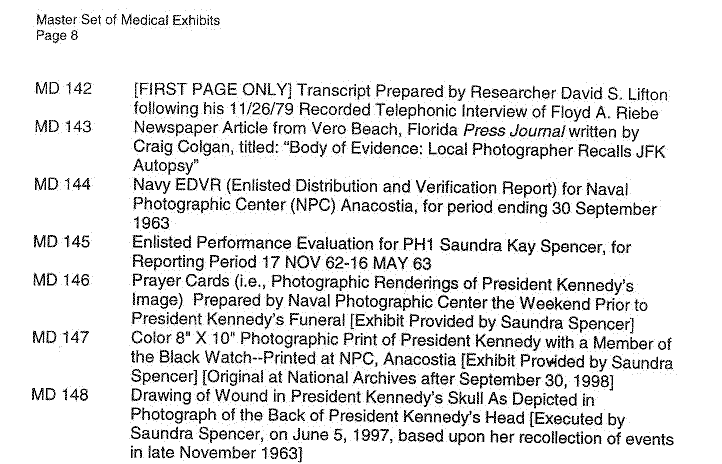
Now, to the depositions themselves. I will
not try to discuss them in order of importance. What may seem important
to me may be trivial to you. I will go through them page by page where
I found something that I thought was interesting. The first deposition
in the packet is from FBI Special Agent James W. Sibert. One of Special
Agent Sibert's pet peeves is the incompetence of the Warren Commission
staff. In particular he claims that Arlen Specter deliberately lied about
what Sibert had said and falsified the record.
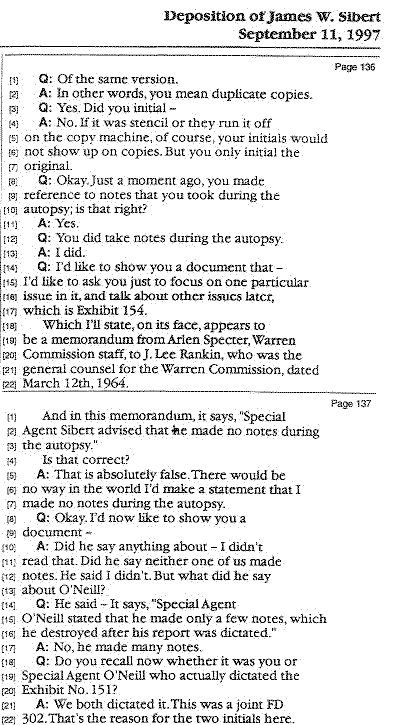
I didn't find anything interesting Riebe's
deposition. David Lifton has covered his story very well.
Edward F. Reed was the radiologist who actually took the X-rays and
had a very close-up view of the body. Again, Lifton has covered this area
well, so I found only one curious thing. Along with each deposition is
a word index which lists every word transcribed and cites all page and
line references to each word. Just looking at that index I could find no
mention of the word "Waters." It has been stated that one of the A-P X-rays
was taken in the modified Waters position, yet neither the ARRB nor Reed
brought up that subject. Some careless researchers have stated that the
word "Waters" was actually written on the film. Yet when Reed was asked
to describe what marker indications there were on each film, he only mentioned
the well-known standard markings.
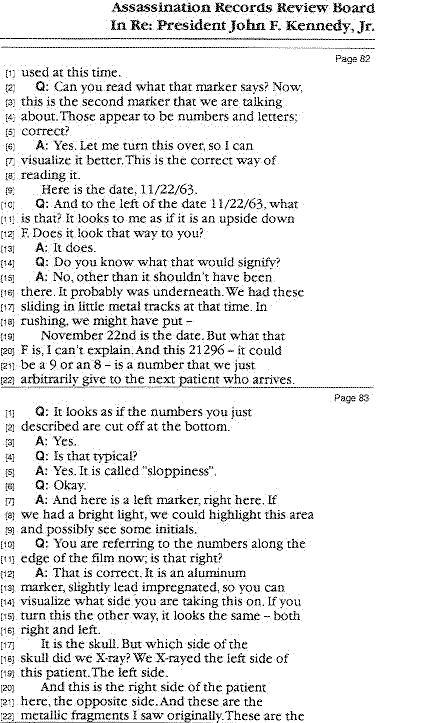
Likewise, Jerrol Custer has been well covered
by Lifton. But Pierre Finck is the odd-man hypothesis. Here is a condensed
version of the third autopsist's memory:
Q. Is your name Pierre Finck?
A. I don't remember.
Q. On November 22, 1963 did you perform an autopsy on President Kennedy?
A. I don't remember.
Q. Where do you live?
A. I don't remember.
Thank goodness the ARRB had all the original autopsy materials available
to occassionally refresh Dr. Finck's memory. It seems that Dr. Finck did
indeed take notes during the autopsy, but Dr. Humes collected them at the
end of the autopsy and then took them home to burn them in his fireplace.
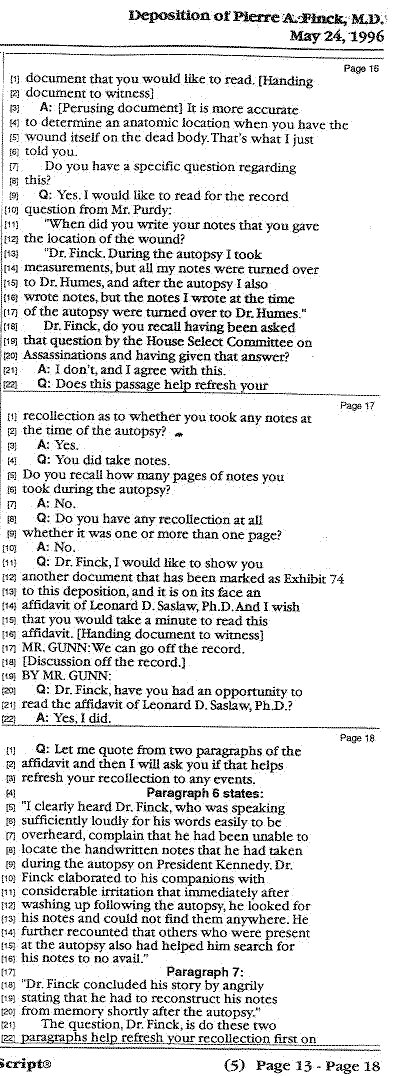
Dr. Finck confirmed that it was Captain Stover
who had ordered the autopsy doctors not to talk to anyone about the autopsy.
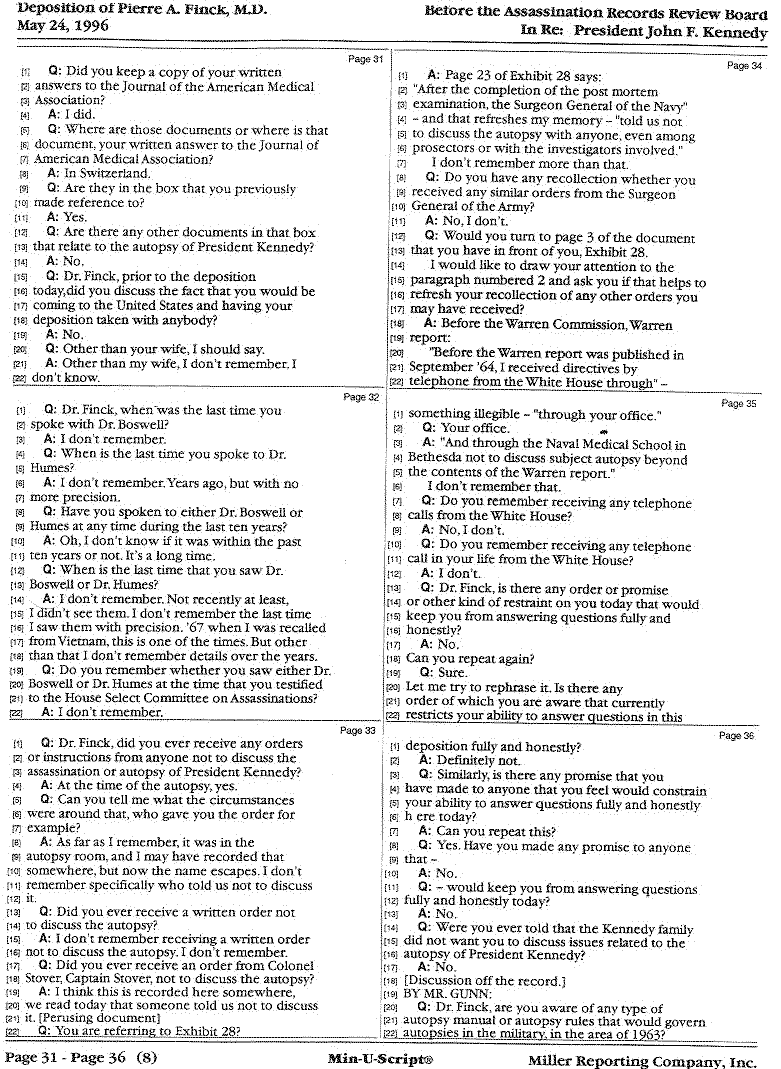
Dr. Finck thought that Dr. Humes had X-rayed the brain, or maybe he did himself, but he can't remember. Reminds me of the 3 Stooges, "Hey Moe, I thought YOU X-rayed the brain.
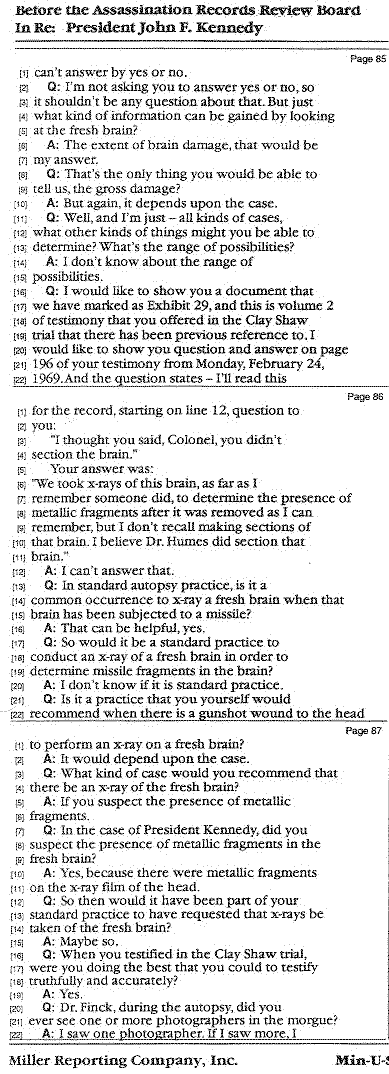
Dr. Finck arrived at the auropsy room after the brain
had been removed.
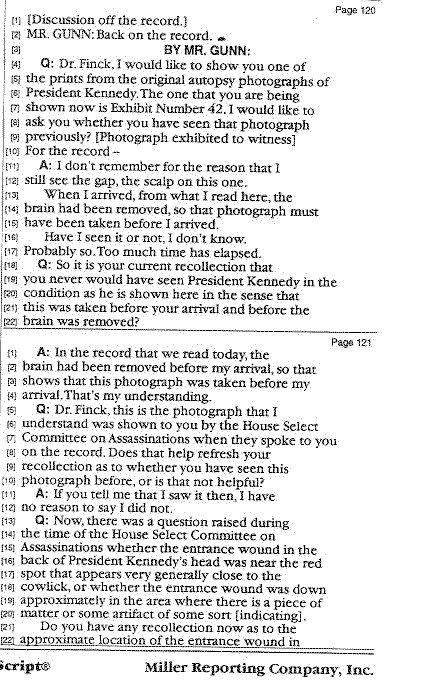
Francis X. O'Neill, Jr. was the other FBI
agent with Sibert who observed the autopsy, took notes, and submitted a joint report.
His recollections may be the cornerstone which proves that the autopsy itself
was a cover-up. He stated that at the end of the autopsy, the conclusion that
Commander Humes had reached was that one bullet struck the President in the back,
only penetrated a couple of inches and worked its way out during cardiac massage.
This was not just a passing theory or supposition by Humes. It was the only
possible solution. Why, because none of the autopsy doctors knew that night
before the autopsy was over that there had been a throat wound. There was
no other point of exit for the back wound and no bullet was found in the body.
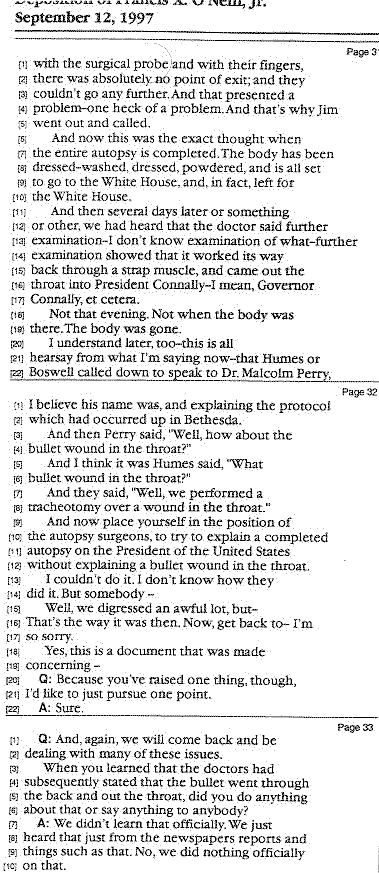
O'Neill suggests the likelihood that Dr. Humes was
either recording the autopsy or narrating for the benefit of an assistant taking
notes. His manner of speaking was the same as most autopsy doctors use when
they are tape recording their observations.
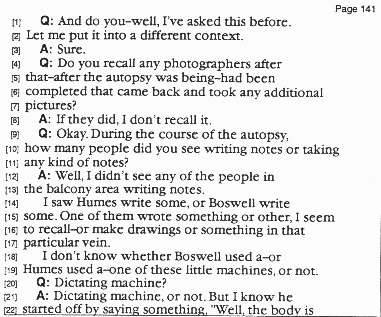
Is this a cover-up or what? O'Neill intentionally
destroyed his notes so that no one would be able to subpoena them. And he
claims that this is standard FBI procedure.
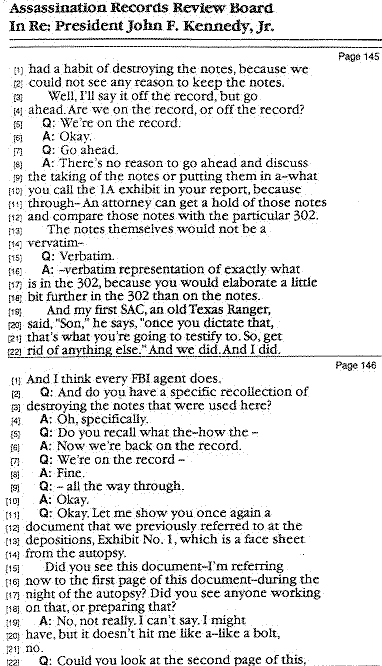
O'Neill agrees with Sibert's opinion that Arlen
Specter intentionally misquoted him and falsified the record.
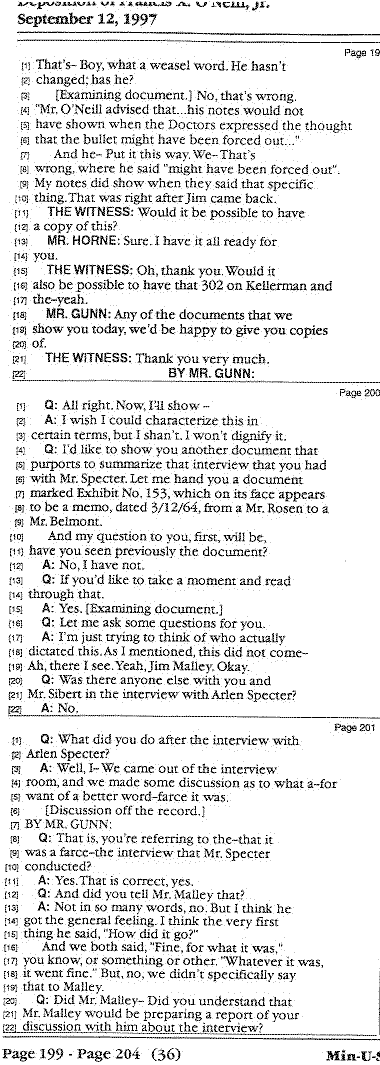
Saundra Kay Spencer was a lab technician at the
Naval Photographic Center on the night of November 22, 1963. Someone brought
in 4 x5 holders of film for her to develop and warned her not to examine them.
She examined the original autopsy photos at the National Archives and found
that they were printed on a different type of Kodak paper than the prints she
made for the unnamed agent. And the appearance of the President's body was
markedly different from the autopsy photos.

Saundra Spencer feels that the photos she
developed that night were taken after the autopsy. This may corroborate
that Knudsen did indeed take photos of the President in the autopsy room,
but it suggests that the photos he took were not autopsy photos as defined
under the JFK Records Act and thus must be turned in as JFK records. My
guess is that Knudsen was asked to take these photos by Admiral Burkley
for the benefit of the Kennedy family, and they were probably given
to Robert Kennedy or one of his aides.
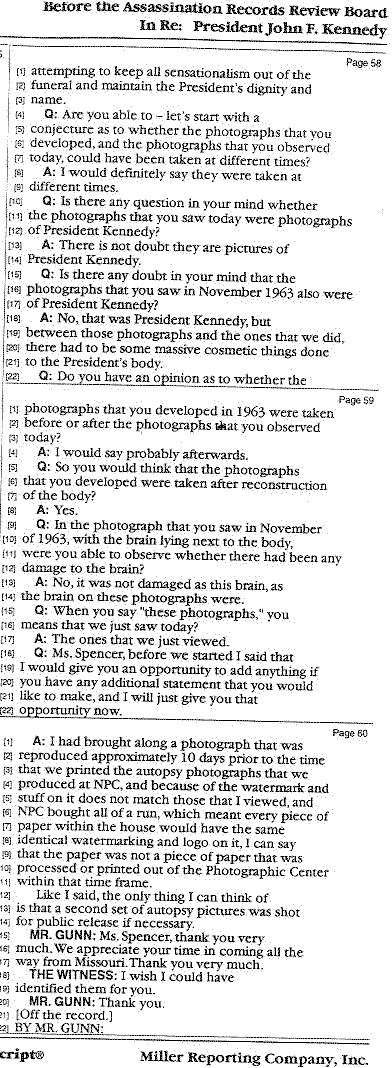
John Stringer was one who actually took
the official autopsy photos. He was ordered to not talk to anyone about
the autopsy by Captain Stover, who seems to be the mastermind of this
cover-up. Yet, interestingly, as I have been saying for many years,
the masters of the cover-up would make an exception only for a pro-Warren
Commission author, in this case John Lattimer. That is how a cover-up operates.
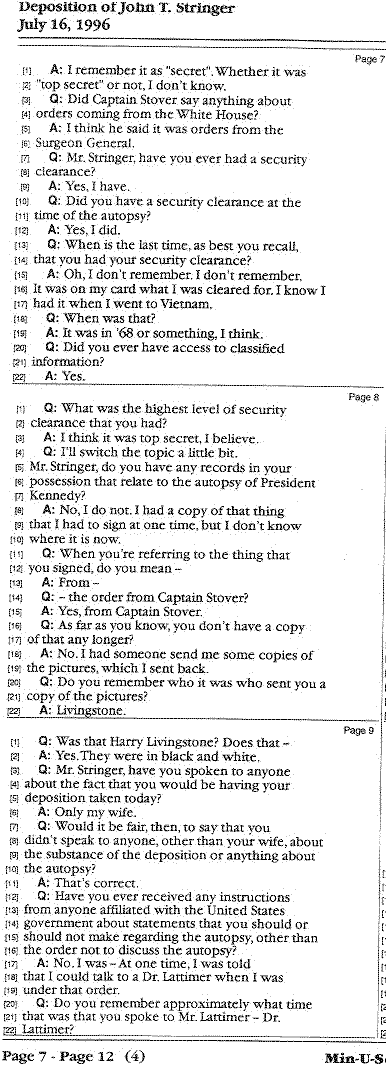
Even Captain Stover, master of the cover-up was
under orders from a higher authority. Stringer says that he was ordered
to obey whatever orders were given to him by someone in plain clothes
who might have been a CIA agent. This is the first time that we have heard
that the CIA might have been in charge of the autopsy.
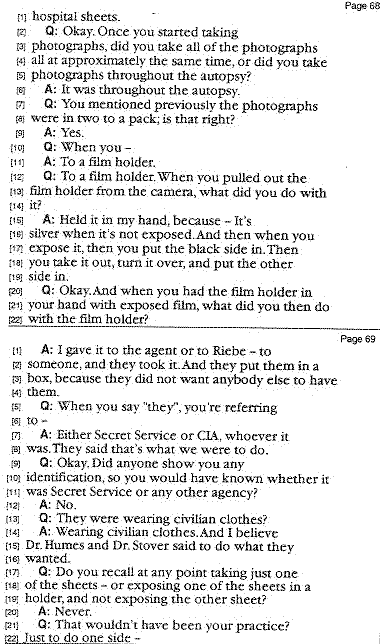
Stringer did not want to sign the memorandum from
Captain Stover to Secret Service agent Roy Kellerman verifying how many photos
hade been taken. Stringer disagreed with Stover's flat statement that there
were only 16 photos taken. But Stringer had no choice. Stover ordered him
to sign the memorandum, changing the number of film holders from 11 to 8.
That is direct evidence of the power to control the evidence. In a flash, 6
photos were made to never have existed, much like the way IngSoc could erase
history in "Nineteen Eight-Four." This is direct evidence of the cover-up
and an example of falsifying the record and suborning perjury.
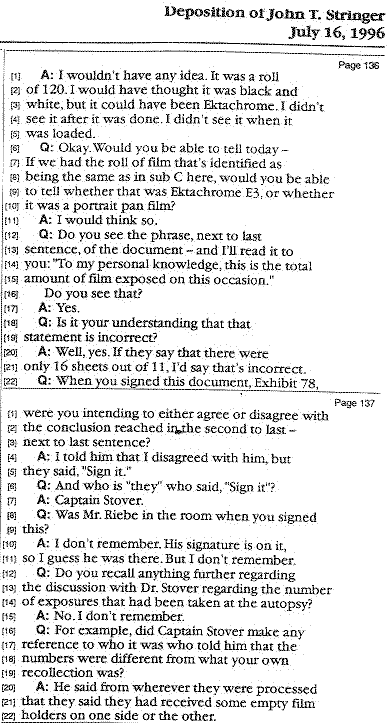
Missing from this batch are the most important
suspects, Humes and Boswell. I hope that someone will be able to upload
examples from their depositions. And someone will have to visit the National
Archives on September 30th and figure out a way to photograph MD 74(M) so
that everyone can see it.
One of the most exciting developments for
someone like me who believes in the potential of technology is the
announcement that Kodak digitized the autopsy photos and developed
the autopsy photos which were previously thought to have been exposed blank.
It is exciting that we may, in our lifetimes, finally be able see all the real evidence.
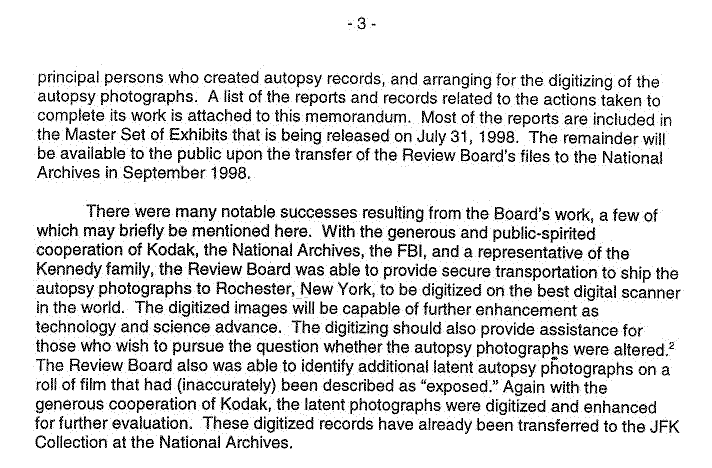
We should all thank Kodak for their generous efforts.
To me, this is a fine example of patriotism and democracy in action.
.gif)

















